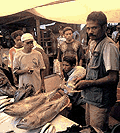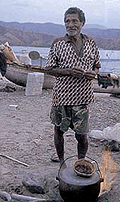 |
 |
|
Story : Dr. Charnvit Kasetsiri
Photo : Vanchai Tan |
|
 |
|
Following the conclusion of World War II, many countries in Southeast Asia, upon gaining independence, began the arduous process of rebuilding, reconstructing, and in essence, reformulating a nation. In a national referendum held on 30 August 1999, rather late in the century compared to her Southeast Asian counterparts, an overwhelming 78.5% of East Timorese voted for independence from Indonesia. Yet from the onset in East Timor, the level of difficulty with which reconstruction began seemed exponentially increased.
The destruction imposed upon what infrastructure, schools, and hospitals the East Timorese had was astounding. Now, rebuilding will take not only time and effort, but most importantly, a lot of money. Take the monetary example of the University of East Timor. Owed to a lack of funds, the University is only able to accept 500 students out of the more than 5,000 that apply each year. The future of East Timor is dependent upon this generation, and an inability to properly educate them will have an adverse affect of East Timor's development. |
 |
|
Then there is the issue of national reconciliation, in essence, nation-building. Besides a desperate lack of funds, the more crucial task of molding and creating, a sense of "nation" is incredibly imposing. After the Dutch left Indonesia, she managed to unite her peoples under a common language, a feat that is credited with endowing Indonesia with their "nationhood." In East Timor, the population uses four languages...
The obstacles facing East Timor today are in the least, extremely challenging. They are in the midst of recreating themselves... what more can the international community do to help?
|
| |
|
|
|